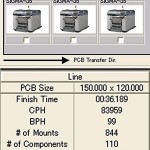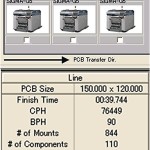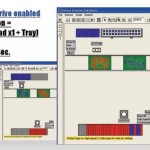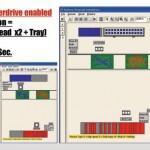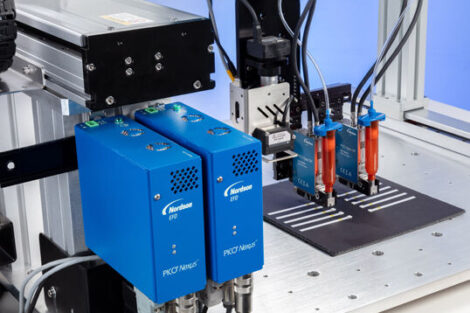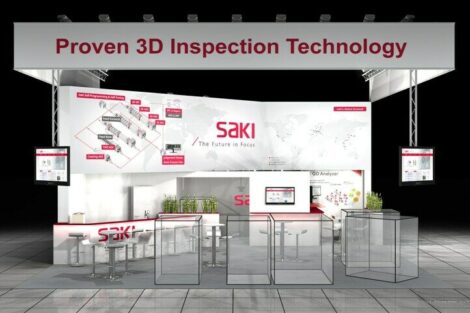Electronics manufacturing and assembly environment is under pressure: profit margins are narrow; up-time is key to productivity and profit. And at the same time, the high product mix requirements are complicated by widely variable product quantities. Setup and changeover requirements go hand in hand with high-mix production and short runs. Additionally, the less flexibility the assembly equipment has in accommodating changeovers, the more time such changeovers take, and these cumulative operational losses directly affect throughput and profitability.
Tom Simpson, Production Systems Division, Hitachi HTA
From the above it becomes clear that the goal, therefore, is to maximize equipment flexibility and capability to minimize changeover time and the required operator intervention that accompanies it. Increased production volume is always a good sign, but the company may not have the resources available – including manufacturing floor space – to run out and buy an additional piece of capital equipment to accommodate it. How then can the manufacturer increase capability when needed without having to make a major investment in a new line or a huge machine?
The answer lies in maximizing the flexibility of existing equipment, and to develop means of sharing equipment resources so as to not require duplication whenever possible. The result is simply more efficient use of all resources without requiring more options, modifications, or new capital equipment investment, a ‘lean’ approach to today’s moving target of competitive profitability.
Overdrive functionality – sharing flexibility
To answer this challenge, Hitachi High Technology Instruments (HTA) developed and patented the concept of overdrive functionality to expand the capabilities of its Sigma G Series high-speed modular mounters and bring greater flexibility to the assembly process using shared system resources with different line configurations (e.g., single lane, dual lane). In simplest terms, overdrive functionality enables both placement heads (high speed (HS) and/or multifunction (MF) to pick from each other’s component supply – on either side of the machine – and place on the same board simultaneously and without restriction, and without sacrificing accuracy or quality. This functionality has never been achieved before with any placement systems.
With conventional placement systems, each head has specific nozzle stockers; and this in turn requires that the stockers of each head have sufficient nozzles to allow flexibility. This means an extra inventory cost, for the non-100% utilization of resources, i.e., idle nozzles. An alternate approach, though no less beneficial, is to change out nozzles by hand from one head stocker to the other, when there are program changes. This might yield closer to 100% utilization of nozzle resources, but the tradeoff is more down time and the risk of human error. It’s the same issue as with machines requiring head changes, one of under-utilized resources.
Overdrive functionality is a ‘game changer’ in that the machine automatically takes nozzles from any stocker in the machine as needed to achieve the optimized setup without human interaction. This provides a tremendous advantage, particularly with high speed machines (two HS-heads, no MF-head) because it allows the heads to share one another’s nozzle stockers. Redundant inventory is eliminated, especially advantageous when that inventory may be only occasionally used; and downtime is slashed dramatically.
With a placement machine equipped with both front and rear component supplies, both heads can pick from either supply as needed. Feeder changes are not necessary, nor do heads need to be exchanged, because each head has unlimited access to both the front and rear component supply. Additionally, both heads can share options, such as a high-resolution camera as the assembly task requires. It isn’t necessary to have a high-resolution camera for each head, or for one head to be restricted to the high-resolution applications. Increased optimization and flexibility of the overdrive functionality help achieve increased levels of productivity with zero line configuration changes, saving time and money.
Shared options: no need for line reconfiguration
Shared options are a key feature of the Hitachi overdrive functionality and a major advantage to the user in terms of flexibility and production quality. Coplanarity is one example. In the event that, due to feeder restrictions, a component was placed on the side of a machine without coplanarity, a conventional machine would require a second coplanarity unit which is a very expensive proposition. In the case of overdrive, since both heads have total access to both sides of the machine, a component from the feeder side of the machine can easily be picked by either the HS or MF head and scanned by the coplanarity module.
Consider another scenario. The fluxing module is usually included with the tray supply-side of the machine and, due to the consequent loss of feeder positions, if a larger component feeder will not fit next to the flux module, the customer would then have two options. First, remove the HS-head on the opposite feeder bank with a MF-head, and add a second fluxing module; however this would have a significant detrimental effect on the machine cycle rate. The second option would be to add an additional machine to the end-of-the-line to increase machine throughput, an expensive proposition that would also require more floor space, etc. With overdrive, however, the single MF-head has the ability to pick from the opposite feeder bank with minimal effect on the cycle rate, and eliminates the need to duplicate options or add an additional machine, a considerable saving in equipment investment and line reconfiguration.
Overdrive functionality, and the result of sharing resources, can also make room for a reject conveyor. In the instance of having multiple large feeders (due to component size) and/or the inclusion of the flux module on the tray unit bank of the machine, there would be no space for a reject conveyor, which provides the means of removing rejected components and saving them for possible refurbishing and re-use. Without this conveyor, the users‘ only choice would be to move faulty parts to a reject bin, possibly damaging it further. But with overdrive, the conveyor could be relocated to the opposite feeder bank and rejected components could be saved and reworked for use later.
Fewer heads and head changes
Dual lane overdrive functionality eliminates the need for additional heads or equipment. Production lines are complex: challenges include large components, and a lack of feeder slots beside the tray. Utilizing overdrive functionality, component pickup from opposite sides for each head is possible with no restrictions. There is no need for head changes or additional equipment due to a lack of feeder positions on a specific side of a machine.
Overdrive functionality allows the user to adapt to varying production requirements without reconfiguring the line. The following capability study was done to illustrate this point. In this study, as in practically all cases, board complexity determines line configuration. Board A was a complex assembly, a unit used for automobile navigation:
- PCB size: 150 x 120mm
- 110 unique components
- 844 component placements
The manufacturer needed a 38-sec cycle rate. The presence of multiple connectors and large devices required the use of a MF-head to place special reeled and tray components. The line consisted of three Sigma G5 series systems, with 5 HS-heads, 1 MF-head, plus the tray. With overdrive, the cycle time realized; but without overdrive, and using a necessarily different line configuration (4 HS-heads, 2 MF-heads + tray), cycle times exceed the requirement; which will not do. In almost all situations, without the use of overdrive, cycle times will be slower without head replacement.
In order to achieve the required cycle rate on Board A, a conventional SMT line without overdrive would require an additional mounter due to feeder space restrictions. In this example, we can see that overdrive provides the necessary flexibility such that it is not necessary to add more machines to the line in order to meet cycle time and throughput requirements. Overdrive thus provided for a significant reduction in the investment for the production of this product.
Conclusion
Overdrive functionality expands the flexibility, capability, and speed of the Sigma G5 modular mounter. By optimizing the use of available features and machine resources, and sharing them between the two operating HS and MF-heads, ownership costs are minimized through resource sharing; changeover times are minimized through greater flexibility; throughput and yields are boosted via streamlined optimization; and productivity increases are realized without the need for configuration changes. Realistically, overdrive functionality coupled with the mounter can eliminate the need for investing in additional SMT placement equipment that would otherwise be necessary.
SMT Hybrid Packaging
Booth 7-438
Zusammenfassung
Neben dem hohen finanziellen Aufwand beim Invest in weitere Linien bzw. Maschinen spielt auch die verfügbare Fläche in der Fertigung eine große Rolle. Einen völlig anderen Weg geht Hitachi mit seiner patentierten Overdrive-Technik. Hier können High-Speed und Multifunktionsköpfe nach Bedarf in einem kompakten Mounter gemischt werden und simultan ein Board ohne Restriktionen von verschiedenen Feederbanken bestücken. Das reduziert nicht nur die Kosten sowie Taktzeiten, sondern erhöht signifikant die Flexibilität und Funktionalität.
Parallèlement aux dépenses financières élevées lors de l’investissement dans d’autres lignes ou d’autres machines, la place disponible dans la fabrication joue également un grand rôle. Hitachi emprunte une voie totalement différente avec sa technique Overdrive brevetée. Ici les High-Speed et les têtes multifonctions peuvent être mélangées dans un Mounter compact en fonction des besoins et simultanément équiper un Board sans restriction avec différents chargeurs. Cela ne réduit pas uniquement les coûts et les durées de cycle, mais augmente également la flexibilité et la fonctionnalité de manière significative.
Share:



